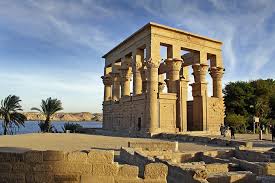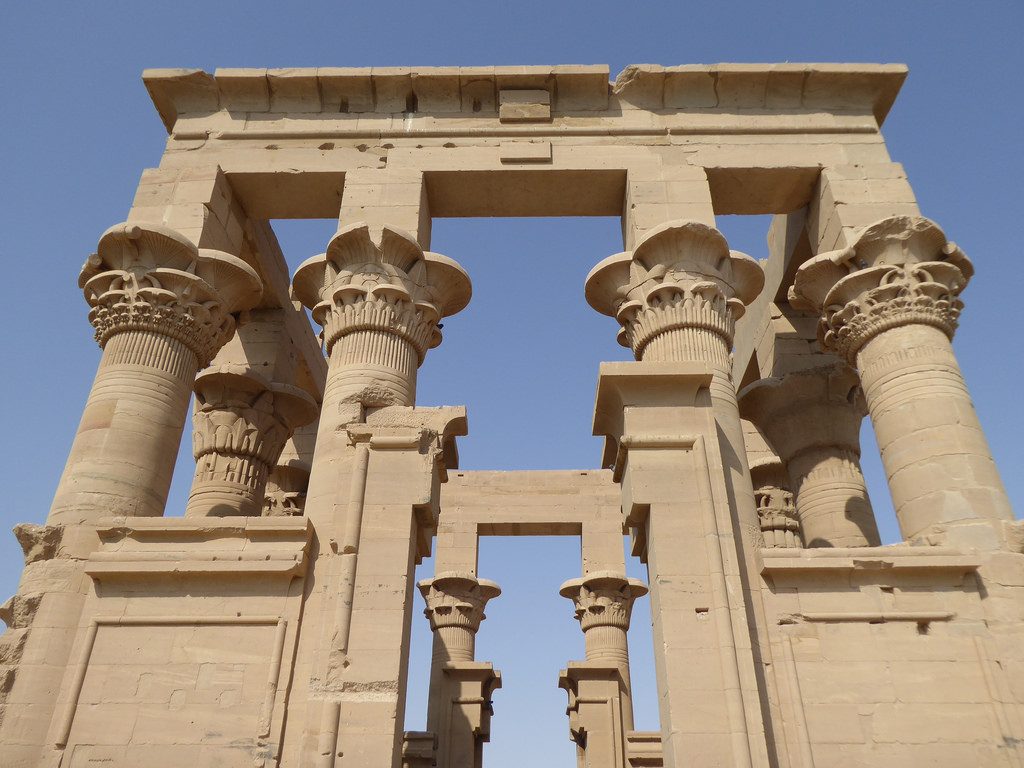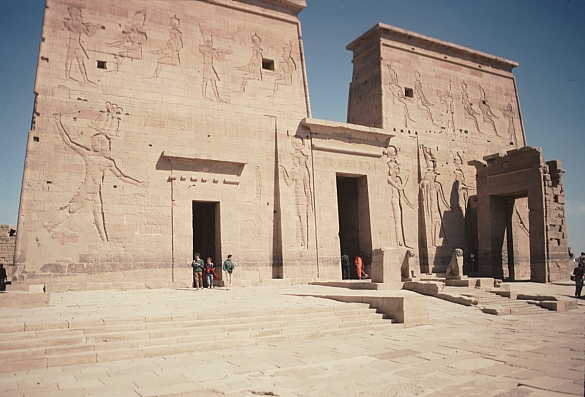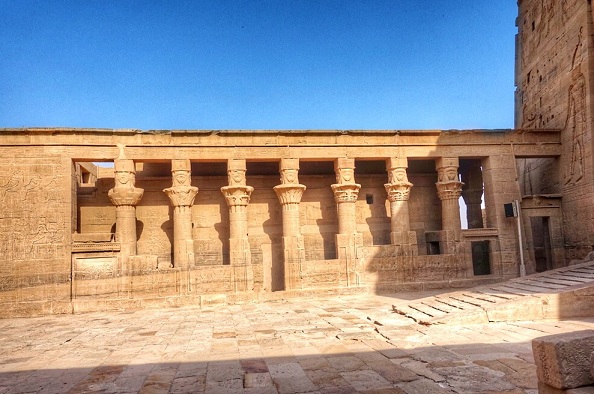
The original site of the temple is the Island of Philae which disappeared under the waters of the middle lake between the Old Dam and the High Dam, after the building of the latter. Before the High Dam, and during the summer months, the Philae Island suffered every year from the Nile flood and visitors had to use boats that sailed within the capitals of its columns.The Old Dam created a lake extending south about 225 kilometers until reaching the Sudanese border and Philae was flooded each year during the summer months. Visitors had to use boats passing through the pylons and the capitals of the temple's columns. The temple was not affected much except for the paintwork which was washed away by the waters of the lake. With the construction of the High Dam, Philae had to be saved like many other monuments of the Historical Nubia, or else, it would have remained trapped between the two dams. Works for the salvation of the temple began in 1970 and lasted for almost 10 years when, at last, the monuments of the island were moved to Angelika, northwest of Philae Island. Since waters already covered the monuments at Philae, the Italian engineers had to build a cofferdam around the island and then pump the water out. The new location was carefully landscaped to resemble the original landscape of Philae as much as possible. More than 40,000 blocks, weighing about 20,000 tons were moved to the new location.
The temple was the last of Nubian temples to be moved, as it was already submerged and it was not finished until 1980, when its reassembling on the neighboring Angelika Island by an Italian expedition was completed. In ancient times, the site, with speedy and turbulent falls, was considered a sacred place, as the Ancient Egyptian thought it was the first ground created from Nun (the original ocean) out of Chaos. It was also here where Isis raised her son Horus and where a part of Osiris body was found. The Ancient Egyptian thought also that Hapi, the god of the Nile, lived in this place . The Taharqa altar to Amun is the earliest evidence of structures on the island. The first building of the temples dates back to the 26th Dynasty, but the major part of the building is from the roman period when the Cult of Isis had a great popularity in the Mediterranean countries. The cult of Isis was practiced in its island until the 6th century when the temple was finally closed by Justinian in 550 A.D, and later was converted into a Christian church. In fact, Philae was the last surviving outpost of the old Egyptian pagan religion. Besides the temple itself, the complex contains other beautiful buildings such as the Vestibule of Nectanebos at the entrance of the temple, Temple of the Hadrian, The Temple of Hathor, Trajan's Kiosk and a birth house . The tourist can also enjoy a magical experience by night of the Sound and Light Show, with fantastic views and magical stories of the place.

This is one of the earliest still surviving monuments in the island and it dates back to the 30th dynasty. It lies at the beginning of the Ancient Quay where boats now land at the southwestern corner of the great temple. This is a hall with screen walls linked by Hathoric columns. Only six of these columns remain. The screens between the columns are crowned with rows of uraeus-serpents and they represent making offerings to gods. On the Other hand, the Kiosk of Trajan is one of the most popular monuments of Philae. It is a rectangular building with fourteen columns with beautifully carved floral capitals that once were supporting a wooden roof. Only two of the screen walls between the columns are completed. The scenes show the Emperor Trajan making offerings to Isis, Osiris and Horus. The Kiosk is often ascribed to Trajan, but might have, as well, been built earlier than this, possibly during the reign of Augustus. From the Kiosk, we can see on the waters of the lake remains of the works of the Italian expedition that moved the temple from the now disappeared Philae Island to its actual location on Angelika Island.The
First and Second Courts of Philae Temple
The First Court of Philae Temple lies between two colonnades in front of the first pylon. The left colonnade is the more complete and it contains thirty-one columns, of the original thirty-two, with floral capitals. The walls behind it have windows that once looked out onto the island of Biggeh. In the court yard and towards the left colonnade, a nilometer descends the cliff. Most of the columns show reliefs of Tiberius offering gifts to the gods. The ceiling was once decorated with stars and flying vultures. The right colonnade, with seventeen columns, was never finished and only six of the columns have their capitals completed. When you are almost reaching the first pylon, to the right side, you can see the Gate of Ptolemy II (Philadelphus), with depictions of the Ptolemaic Pharaoh led by Isis. In front of the entrance at the first pylon, there are two Roman-style lions carved in pink granite. Also, there were two obelisks erected by Ptolemy VIII Euergetes, which are now at Kingston Lacy in Dorset in the UK. In the corner of the forecourt, near the pylon, stands the earliest work at Philae, the granite altar of Taharqa. To the south of the right colonnade lies the remains of the Temple of Arsenuphis which was a Nubian lion-god. This temple was built by Ptolemy IV Philopator and was extended by Ptolemy V Epiphanes. The scenes on its wall depict the king worshiping Isis and other gods.
Behind the Temple of Arsenuphis lie the ruins of the Chapel of Mandulis, who was a Nubian god. This chapel was built by Ptolemy V, who appears in the scenes worshiping the deified. The Second Court, on the other hand, was built by Ptolemy XII. This court has columns with floral and palm leaf capitals that support a cornice with row of uraeus-serpents. There are six doorways that lead, through the rear wall of the colonnade, to small annex storerooms. Just before the second pylon, there is a a small Roman chapel in the northeast corner which was built on a natural outcrop of a rock and stands at an angle to the outer entrance.

The First Pylon of Philae Temple measures 45 meters wide and 18 meters high. It has two towers with a gate between them which leads to the Second Court. On the pylons, you can observe grooves that were used for flag poles. The pylon was first started by Ptolemy II Philadelphus and was finished by Ptolemy III Euergetes I, however, the decorations have never been finished. On the right tower, the scenes represent Ptolemy XII Neos Dionysos, blessed by Isis, Hathor and Horus, submitting the enemies of Egypt. Above this scene, Ptolemy XII presents the crown of Upper and Lower Egypt to Horus and Nephthys (sister of goddess Isis). On the left towers, we can see the same scene of submitting the enemies in front of Isis and Horus although these reliefs were damaged by the early Christians. Along the whole bottom of the first pylon, there are reliefs of Hapi, the Nile god, bringing welfare to Egypt. The gateway was built by Nectanebo I of the 30th Dynasty.
On both sides of the gateway, there are Coptic Christian crosses carved. There are also a French inscription recording the victory of General Desaix over the Mamelukes in 1799. In the rear part of the Pylon, we can see Ptolemy XII Neos Dionysos and Ptolemy XII standing before various deities. The Second Pylon of Philae Temple, on the other hand, measures 45 meters wide and 32 meters high. On the towers there are scenes representing Ptolemy XII making offerings to Horus, Hathor and other gods, (some of them are badly damaged). Like the first pylon, the towers have grooves for flags. At the base of the right tower, part of the granite foundation of the original island protruded and it was carved into a stele on which Ptolemy VI Philometor and his queen Cleopatra II stand before Isis and Horus. On the right side of the doorway, there is an inscription for the Christian Bishop Theodorus.

From the First Pylon, the left tower, there is a small door that leads to a small room which opens onto a stairway and this stairway leads to the roof (now closed). After that, we find the Birth-House, or Mammisi. The idea of the birth-house had begun during the reign of Hatshepsut, in The Deir-el-Bahari Temple, to justify her coronation as a pharaoh in spite of her being a woman. This concept was also used by the Ptolemaic Kings, though being Greek, to gain legitimacy. In the Mammisi, you can learn the second chapter of the Legend Of Isis, Osiris and Horus, where Isis came to Philae, and being assisted by many deities, she raised her son and prepared him to recover the throne of his father and become the king of Egypt. In the sanctuary of the Mammisi, Horus, the King, is represented as a falcon wearing the Double Crown and standing, while Isis is represented carrying the newly born Horus in her arms. A colonnade is surrounding three sides of the Birth-House, with floral column capitals surmounted by Sistrum capitals with Hathor heads. The screen walls between the columns depict Ptolemy VI, VIII and X as well as the Roman Tiberius in the presence of various gods.
After the Second Pylon, we reach the -once was- Hypostyle Hall. Some of the columns were removed by the early Christians to convert the place into a church. There is also a Christian altar dates back to 500 AD. Three small antechambers lead to the sanctuary which still contains the pedestal for the statue of Isis and her sacred bark. The sanctuary is lit by two small windows. The scenes in the sanctuary glorify Isis as a protector goddess that resurrected her husband by her wings.
To the north of the Temple of Isis, we can see ruins of the Temples of Claudius and Augustus, the Roman town gate that leads to a quay, two ancient Coptic churches as well as the Temple of Hathor. The walls of the Temple of Hathor are filled with carvings of festivities where we can find scenes of music and drinking. Here, Augustus is represented while making offerings to Isis and Nephthys. Scenes of the dwarf beating a tambourine and playing a harp can be seen as well.
